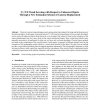Free Online Productivity Tools
i2Speak
i2Symbol
i2OCR
iTex2Img
iWeb2Print
iWeb2Shot
i2Type
iPdf2Split
iPdf2Merge
i2Bopomofo
i2Arabic
i2Style
i2Image
i2PDF
iLatex2Rtf
Sci2ools
IJCV
2000
2000
2 1/2 D Visual Servoing with Respect to Unknown Objects Through a New Estimation Scheme of Camera Displacement
Classical visual servoing techniques need a strong a priori knowledge of the shape and the dimensions of the observed objects. In this paper, we present how the 2 1/2 D visual servoing scheme we have recently developed, can be used with unknown objects characterized by a set of points. Our scheme is based on the estimation of the camera displacement from two views, given by the current and desired images. Since vision-based robotics tasks generally necessitate to be performed at video rate, we focus only on linear algorithms. Classical linear methods are based on the computation of the essential matrix. In this paper, we propose a different method, based on the estimation of the homography matrix related to a virtual plane attached to the object. We show that our method provides a more stable estimation when the epipolar geometry degenerates. This is particularly important in visual servoing to obtain a stable control law, especially near the convergence of the system. Finally, experim...
| Added | 18 Dec 2010 |
| Updated | 18 Dec 2010 |
| Type | Journal |
| Year | 2000 |
| Where | IJCV |
| Authors | Ezio Malis, François Chaumette |
Comments (0)

